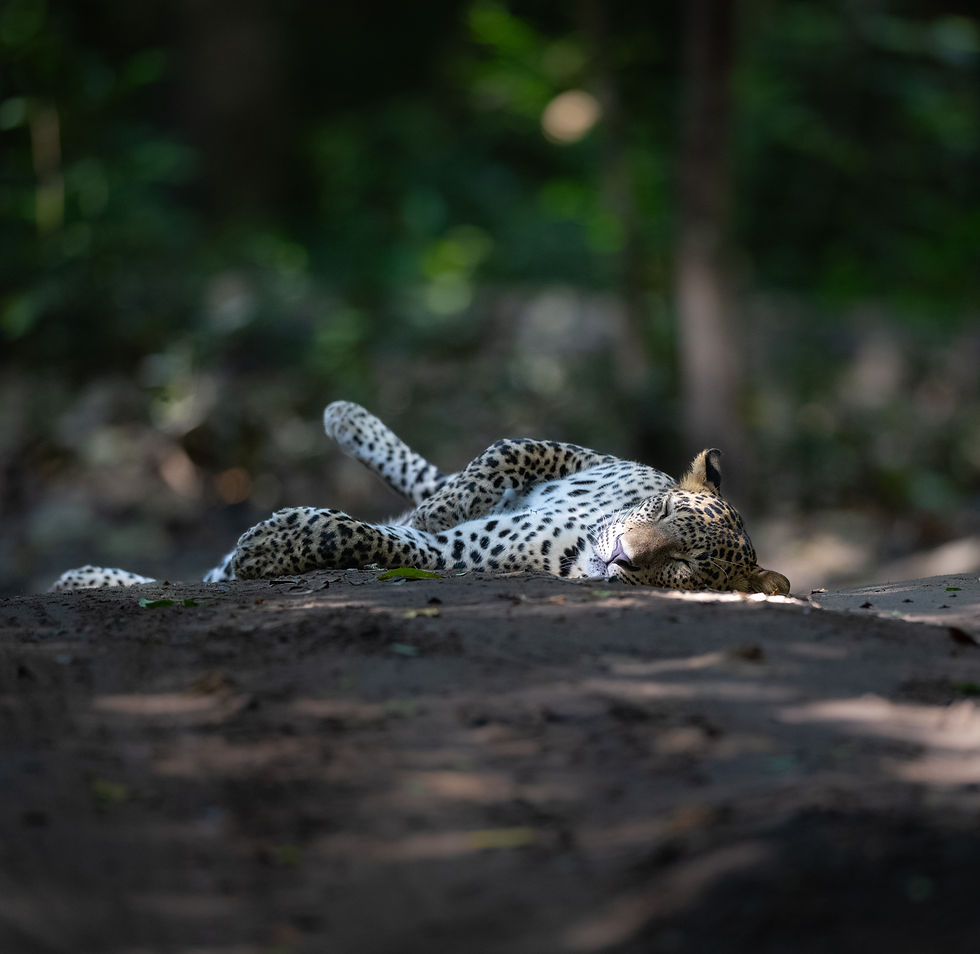The Enigmatic Presence of Sri Lanka's Leopards: Guardians of the Wilderness
- dinukaranasinghe19
- Jun 20
- 3 min read
Sri Lanka boasts breathtaking biodiversity, filled with lush forests, sprawling savannas, and diverse wildlife. Among its standout residents is the Sri Lankan leopard (Panthera pardus kotiya). Known for its stunning appearance and elusive behavior, this magnificent cat plays a vital role in the ecosystem. In this post, we will explore the unique characteristics, preferred habitats, conservation efforts, and the importance of Sri Lanka's leopards. Discover why these felines are truly the guardians of the wilderness.
Characteristics of Sri Lankan Leopards
The Sri Lankan leopard stands out as a distinct subspecies, marked by its larger size and darker rosettes in comparison to African leopards. Adult males usually weigh between 80 and 130 pounds, while females typically range from 55 to 105 pounds.
Their beautiful fur, patterned with intricate spots, serves as perfect camouflage. This allows them to fade into the sunlight and shadows of their environment. Such adaptations empower them as formidable hunters, capable of taking down prey like deer, wild boar, and even monkeys, which can weigh more than themselves.
Leopards are solitary by nature, spending most of their lives alone except during mating or while raising cubs. This solitary lifestyle adds to their allure and makes spotting them challenging, even in protected areas.
Preferred Habitats and Distribution
These leopards prefer a variety of ecosystems, including dry scrublands, grasslands, and tropical forests. For wildlife enthusiasts, two prime locations for leopard sightings are Yala National Park and Wilpattu National Park.
Yala National Park is famous for having the highest density of leopards in the world, making it an excellent spot for excellent viewing opportunities. The park supports an impressive array of wildlife, thanks to its diverse landscapes—grasslands, forests, and wetlands.
On the other hand, Wilpattu National Park is loved for its serene environment and fewer visitors. Here, leopards navigate through dense jungles and open plains, often providing visitors with memorable sightings.

Hunting Skills and Behavior
Leopards primarily hunt at night, when they can blend into the shadows. Their sharp eyesight and acute hearing make it easier to detect movements and sounds from afar.
Once they locate their prey, leopards adopt a stealthy approach, using their powerful muscles to stalk and pounce. Interestingly, they sometimes drag their kills into trees to protect them from scavengers. A leopard can carry a weight equal to its own body weight up a tree—showcasing their incredible strength.
Adaptability is another key trait for leopards. Their diet is primarily composed of ungulates, but when the opportunity arises, they will hunt smaller mammals, birds, and even reptiles. This ability to adjust their feeding habits to the environment plays a significant role in their survival.
Challenges and Conservation Efforts
Despite their adaptability, Sri Lankan leopards encounter significant threats, primarily from habitat loss due to human activities. For instance, the expansion of agriculture and urban areas continues to reduce their living spaces. A study indicated that between 2000 and 2020, over 24% of leopard habitats have been lost.
Poaching remains a critical challenge, with leopards often targeted for their beautiful pelts and body parts. As a result, they are classified as "Endangered" on the IUCN Red List.
Conservation groups and government initiatives are determined to protect these magnificent cats. For example, projects focused on habitat preservation, stricter anti-poaching laws, and community awareness programs are in place. Such efforts aim to create a harmonious balance between human activities and leopard conservation, ensuring these animals thrive in the wild.
Cultural Importance
Leopards hold a prominent place in Sri Lankan culture and folklore, representing strength and resilience. In ancient stories and artwork, they often symbolize beauty and ferocity and are depicted in traditional carvings and textiles.
Moreover, leopards significantly contribute to wildlife tourism, which is vital for the economy. Each year, thousands of tourists visit Sri Lanka specifically to spot these elusive creatures. The country reported a 15% increase in wildlife tourism in the last five years, underlining the importance of leopard conservation for both nature and economy.
A Call to Action
The alluring leopards of Sri Lanka play an essential role in maintaining ecological balance. Their presence is a clear indicator of the health of the ecosystems they inhabit, reminding us of the interconnectedness between wildlife and the environment.
To protect these majestic felines, collective action is essential. Governments, local communities, and conservation organizations must cooperate to promote awareness and responsible tourism. By doing so, we can ensure the leopards of Sri Lanka continue to roam freely in their natural habitats for future generations.
In a world confronting numerous wildlife challenges, understanding and protecting Sri Lanka’s leopards is more important than ever. These enigmatic cats are a vital part of the island's rich biodiversity and remind us of our responsibility to safeguard our planet's natural heritage.



Comments